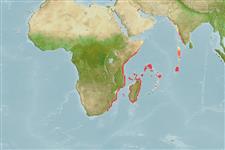>
Ovalentaria/misc (Various families in series Ovalentaria) >
Pseudochromidae (Dottybacks) > Pseudoplesiopinae
Etymology: Chlidichthys: Greek, chlidos, -eos, ous = collar, bracelet, adornment + Greek, ichthys = fish (Ref. 45335).
More on author: Smith.
Environment: milieu / climate zone / depth range / distribution range
Ecologia
marino associati a barriera corallina; distribuzione batimetrica 10 - 27 m (Ref. 11228). Tropical
Western Indian Ocean: Tanzania, Ibo (Mozambique), Comoros, and Sodwana Bay, Natal (South Africa).
Size / Peso / Age
Maturity: Lm ? range ? - ? cm
Max length : 5.0 cm TL maschio/sesso non determinato; (Ref. 11228)
Short description
Chiavi di identificazione | Morfologia | Morfometria
Spine dorsali (totale) : 2; Raggi dorsali molli (totale) : 22 - 23; Spine anali: 2 - 3; Raggi anali molli: 13 - 14. Dusky olive green in color (Ref. 11228).
Life cycle and mating behavior
Maturità | Riproduzione | Deposizione | Uova | Fecundity | Larve
Heemstra, P.C., 1995. Additions and corrections for the 1995 impression. p. v-xv. In M.M. Smith and P.C. Heemstra (eds.) Revised Edition of Smiths' Sea Fishes. Springer-Verlag, Berlin. (Ref. 11228)
IUCN Red List Status (Ref. 130435: Version 2024-2)
Threat to humans
Harmless
Human uses
Strumenti
Special reports
Download XML
Fonti Internet
Estimates based on models
Preferred temperature (Ref.
123201): 24.9 - 28.9, mean 27.3 °C (based on 370 cells).
Phylogenetic diversity index (Ref.
82804): PD
50 = 0.5001 [Uniqueness, from 0.5 = low to 2.0 = high].
Bayesian length-weight: a=0.01000 (0.00244 - 0.04107), b=3.04 (2.81 - 3.27), in cm total length, based on all LWR estimates for this body shape (Ref.
93245).
Trophic level (Ref.
69278): 3.3 ±0.5 se; based on size and trophs of closest relatives
Fishing Vulnerability (Ref.
59153): Low vulnerability (10 of 100).
